To automatically apply pressure sensitive labels to a product or container, with speed, precision and accuracy, it’s recommended to use a label machine. Both apply-only label applicators – that apply pre-printed labels to a package – and print and apply labellers – which do exactly what their name suggests – can maximise efficiency, while reducing human error and cost.
Automated labelling machines ensure that every product or package is accurately labelled, whether it’s an incoming shipment and an outbound order.
Different Types Of Label Machine
To fit a variety of needs, there are several types of label applicators available on the market:
The most commonly used labeller utilises a contactless labeling technique, known as the tamp-blow method. This is the most practical option for products that have uneven surfaces. Press-on tamp application suits surfaces that are rugged or textured.
Print and apply label machines offer the most flexible applications for a wide range of product types.
Oddly shaped or fragile items are best labelled with a label applicator that uses the fast and easy blow-on method.
Wipe-on application is the recommended option for labels that are longer in length.
Semi & Automatic Label Applicators
Labelling systems are designed to integrate to seamless diverse production line layouts. They are available in left and right hand options, and can also mount at varying angles. Each label machine model is uniquely designed to address specific labeling requirements. They can rapidly apply pre-printed pressure-sensitive labels to all types of products and packaging.
Fast and consistent in-line labelling is achieved with a fully automatic labelling system. The easy maintenance labelling machines boast unsupervised operation functions, with exceptional placement accuracy.
A semi-automatic label applicator still needs some human input.
The Labelling Process
A vast number of industries use labelling machines that automatically dispense and apply labels without the assistance of an operator. Regardless of whether your labeller is small, handheld, and portable, or heavy-duty and automatic, the same labelling process principles apply.
An automatic labeling machine features a built-in control system, and a conveyor that moves products and packages.
For labels to be applied successfully, the surface of your product/packaging must be clean and dry. Ideally, it should also be flat, to ensure even adhesion without any imperfections, like lumps or bumps.
Extreme cold or heat can cause problems with the adhesion of labels. You may want to consider investing in adhesive that is suitable for all temperatures or extreme cold. Or can wait until the labels reach room temperature before applying.
Label Applicator Considerations
As different types of products require variable labelling techniques, there are a number of factors to consider, when deciding on the type of label machine for your business needs.
Is the product profile/surface flat, concave, convex, or irregular? What are the dimensions of the repeat or feed labels? Is the label material pressure sensitive? The location on the product where the label needs to be placed – top, side, corner, or bottom – and the application rate are equally crucial factors to consider.



































